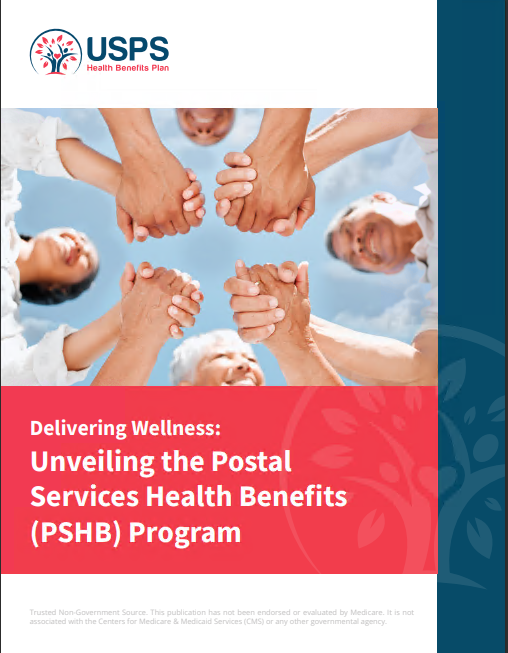Key Takeaways
-
Enrolling in Medicare Part B enhances your PSHB benefits by reducing out-of-pocket costs and unlocking plan features tailored for Medicare users.
-
Some PSHB plans require Medicare enrollment to access integrated drug coverage and lower deductibles, especially if you’re Medicare-eligible.
Why Medicare Matters When You’re on PSHB
Now that the Postal Service Health Benefits (PSHB) Program is fully implemented in 2025, you might be wondering whether adding Medicare to your healthcare mix is necessary. After all, PSHB plans are robust and specifically built for Postal Service employees, retirees, and their eligible family members.
But here’s what’s important: PSHB plans are designed to work with Medicare. If you’re Medicare-eligible and only rely on PSHB, you’re likely missing out on valuable cost-sharing reductions, waived deductibles, and extended pharmacy benefits that come with Medicare Part B enrollment.
What Happens When You Combine PSHB and Medicare
When you enroll in Medicare Part A and Part B and are also covered by a PSHB plan, Medicare becomes your primary payer. That means:
-
Medicare pays first for eligible medical services.
-
PSHB acts as your secondary coverage, filling in most (if not all) of the gaps left behind.
This dual-layer setup significantly reduces your total out-of-pocket expenses. You’ll likely see fewer copays, lower coinsurance rates, and in many cases, your PSHB plan may even waive its annual deductible.
Who Needs to Enroll in Medicare Under PSHB?
Starting in 2025, Medicare Part B enrollment is mandatory for certain Postal retirees and eligible family members to maintain full PSHB benefits:
-
You retired after January 1, 2025, and are entitled to Medicare Part A.
-
You are a covered family member entitled to Medicare Part A based on age or disability.
There are specific exceptions for individuals who:
-
Retired on or before January 1, 2025
-
Are actively employed and aged 64 or older as of January 1, 2025
-
Live abroad
-
Are covered by Indian Health Services or VA benefits
If you’re in one of these exempt categories, you can continue with your PSHB plan without Medicare Part B. However, you’ll likely pay more out-of-pocket than those who pair PSHB with Medicare.
The Pharmacy Factor: Medicare Part D and PSHB Integration
Prescription drug coverage under PSHB works differently once you become Medicare-eligible. You’re automatically enrolled in a Medicare Part D Employer Group Waiver Plan (EGWP) offered through your PSHB plan. This setup:
-
Provides enhanced drug coverage through a Medicare-backed plan
-
Includes a $2,000 annual out-of-pocket cap for prescription drugs
-
Covers a wider network of pharmacies
However, this only applies if you’re enrolled in Medicare Part B. If you skip Part B, you lose access to this integrated drug benefit and risk having no prescription coverage under PSHB at all.
How PSHB Reduces Costs When You Have Medicare
PSHB plans are structured to offer cost savings for Medicare-enrolled members. Here’s how you benefit:
-
Lower deductibles: Many plans reduce or even waive your deductible entirely.
-
Lower coinsurance and copays: PSHB plans often mirror the 80/20 split of Medicare Part B and cover the remaining 20%, resulting in minimal costs to you.
-
Fewer surprise bills: Coordination between Medicare and your PSHB plan limits your financial exposure.
This matters even more in 2025, when the average PSHB plan deductible ranges from $350 to $1,500 depending on the option you choose. With Medicare Part B in place, those numbers drop dramatically.
If You Delay Enrollment in Medicare
Delaying Medicare Part B enrollment without qualifying for an exception can lead to several consequences:
-
Late enrollment penalties that apply for life
-
Gaps in drug coverage under PSHB
-
Higher out-of-pocket costs due to lack of coordination between Medicare and PSHB
If you’re newly eligible for Medicare in 2025, your Initial Enrollment Period spans 7 months—starting three months before the month you turn 65 and ending three months after. Missing this window can cost you financially and limit your PSHB plan’s effectiveness.
What You Gain with Full Integration
The true value of pairing PSHB with Medicare lies in the seamless coverage experience. Together, they give you:
-
Primary and secondary coverage coordination, ensuring most bills are fully paid
-
Comprehensive inpatient and outpatient protection
-
Broad access to providers in both Medicare and PSHB networks
-
Automatic drug coverage with no separate plan selection required
You won’t have to manage two completely separate insurance policies. Instead, your PSHB plan handles much of the Medicare coordination behind the scenes.
What You Could Miss Without Medicare
If you’re eligible for Medicare but choose not to enroll, here’s what might happen:
-
You’ll face full PSHB deductibles and coinsurance
-
You could be denied pharmacy benefits under the EGWP system
-
You may not receive reimbursement benefits some PSHB plans offer for Medicare Part B premiums
-
You’ll pay more out of pocket across the board
In short, your PSHB plan will work, but not nearly as well.
The Timeline That Matters Most
In 2025, the key timelines for Medicare and PSHB alignment include:
-
Age 65: Your Medicare Initial Enrollment Period begins
-
Start of the year you turn 65: You’ll receive communications from OPM and your PSHB plan
-
January 1, 2025 onward: New retirees must have Medicare Part B to maintain full PSHB benefits
For anyone turning 65 this year, planning ahead and enrolling in Medicare as soon as you’re eligible will ensure you get the most from your PSHB coverage.
Costs You Can Expect in 2025
Here’s a general idea of Medicare costs in 2025:
-
Part A: Free if you’ve worked at least 40 quarters; otherwise, premiums apply
-
Part B: Monthly premium is $185; annual deductible is $257
-
Part D: Covered under PSHB-integrated EGWP with a $2,000 out-of-pocket cap
Compare that to PSHB-only costs, which may include:
-
Deductibles ranging from $350 to $1,500
-
Out-of-pocket maximums as high as $7,500 to $15,000
-
Pharmacy coverage limitations without Medicare enrollment
As you can see, Medicare lowers the ceiling on what you spend.
Don’t Assume Medicare Is Redundant
A common misconception is that PSHB coverage makes Medicare unnecessary. But in 2025, that’s far from true. PSHB and Medicare are not duplicates—they’re partners in care. One handles what the other doesn’t.
Skipping Medicare when you’re eligible limits how effective your PSHB plan can be. You may still be covered, but you’ll be paying more, facing more paperwork, and missing key benefits.
Coordinating Your Coverage the Smart Way
In 2025, if you want the most value, protection, and simplicity from your PSHB plan, enrolling in Medicare is not just smart—it’s necessary. With rising healthcare costs, the integration of Medicare and PSHB creates a financial safety net that no single plan can offer on its own.
To make sure your transition is smooth and that you’re fully covered, get in touch with a licensed insurance agent listed on this website. They can help you evaluate your eligibility, understand your options, and make the best choice for your long-term health and finances.











